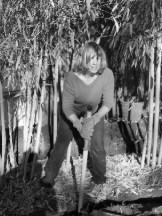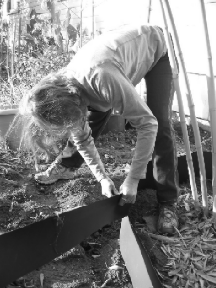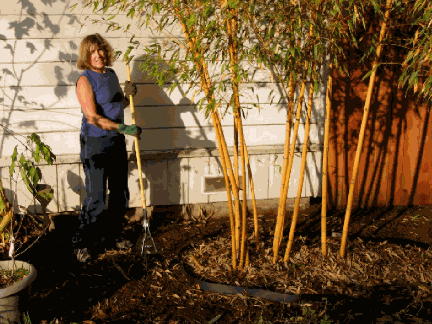| Home || About Us || Contact || Ordering Info || Shipping || Order Form | |||||
| DWARF |
SHRUB | TALL
SHRUB |
TIMBER |
MOUNTAIN |
BOOKS |
Taming the Running Bamboo by Gib Cooper
The Beast: a 6 year old, Phyllostachys viridis, Robert Young grove in a small garden bed.
The Problem: rhizomes out of bounds and growing under Mom’s roses.
The Tamer: Mom’s daughter, Diane is weighing in at100 pounds, well, a little bit over.
Last Thanksgiving, Diane and family came home to Ukiah, California to enjoy the annual holiday get together. In phone conversations with Mom she was hearing the frightening news about how our gift bamboo was threatening her garden universe. Determined to ease Mom’s worry, Diane came prepared with the tools to corral the rampant invader. The next morning with a strong French roast coffee in her hand she admired the beautiful yellow culms and lush foliage of a very happy Bob Young bamboo knowing all the while that hidden from view, the active rhizomes were creating a web of subterranean terror to the neighboring roses.
Ready for action,
Diane selects a hose and
lays out a planned boundary to the small grove that is about five by
twelve feet in size. After Mom’s approval the work begins. First, using
a mattock a perimeter line is drawn in the soil. Diane loves gardening,
so she is aware how difficult bending over to dig down into the soil
can be so she selects and uses hand tools that are easy on the lower
back.
Fig. 1
- Tools L-R Post hole digger, mattock, end clamp and 30
in., 60 mil. plastic rhizome barrier and steel bar
digging tool.

Fig. 2 - Diane
digs surface trench around the bamboo with a mattock.

Fig. 3 - Then
she
deepens it using the posthole digger.

The tool of choice for digging the narrow
trench is not the obvious shovel or even the trenching spade. These
tools require more bending the deeper you dig into the ground. Hence
her selection of the posthole digger and the steel bar
tool. They allow
you to stand upright and dig a trench to the required
24-28 inch depth with relative ease.
The first few inches are not too difficult. Diane uses a mattock and posthole digger to easily lift out the high-grade garden soil (Figs. 2 and 3). Mom’s garden is on an alluvial fan so the going gets tough once she enters the deeper soil. She needs to loosen up round rocks and even cobbles that are in a zone from 12 to 28 inches down. To do this she uses the steel bar to bust up the hard ground and even slice through roots and rhizomes (Figs. 4 and 5). Once the soil is loosened it is lifted out and put aside with the posthole digger. She places the loose soil far enough away from the trench to not be a nuisance by falling back in while she works.
The work is tough and requires her to move at a moderate pace. Most of the family sits around and watches her work during the holidays. Frequent breaks are required for refreshments, food and folly. After a few days of holiday digging the 24-28 inch deep trench is cleared to a uniform depth and larger tree roots sawn through to allow insertion of the rhizome barrier. The distance around the perimeter is carefully measured and a length of barrier with some extra is cut and laid on edge into the trench. The trench is widened at the point where the ends meet. This is where the end clamp is assembled to secure the barrier into a full circle.
Fig. 4 and 5


Fig. 6 and 7


Assembling the end clamp is not for butter-fingers. Diane makes it easier by using two pairs of vice-grips to hold the two clamp pieces in place while drilling holes for the bolt to pass through the plastic. Put the stainless steel nuts and bolts in place and tighten. Notice the ends are turned inward and clamped with the two out sides facing together (Fig. 7).
Fig. 8

Once the trench is refilled with soil then the plastic should be trimmed to a uniform height about two inches above grade (Fig. 8). This is to allow the edge to be visible or easily found under the decorative mulch. Then the soil is raked to grade and the whole area watered in to clean up the mess and give the bamboo some welcome relief after all the commotion from cutting and digging.

Photos and
Text ©
By Gib and Diane Cooper
Tradewinds Bamboo Nursery
28446 Hunter Creek Loop
Gold Beach, Oregon
Tel. (541) 425-5177
On the Web: http://www.bamboodirect.com